#museo kroller muller otterlo
Text

ISAAC ISRAELS, (Ámsterdam, Países Bajos, 1865 – La Haya, Países Bajos,1934).
RETRATO DE UNA CHICA, (Portret van een meisje), ca. 1916. Óleo sobre lienzo,42 x 33 cm. (Museo Kroller-Muller, Otterlo. Netherlands).
8 notes
·
View notes
Photo

Vincent Van Gogh - Sentiero nel parco - 1888
44 notes
·
View notes
Photo

Vincent Van Gogh - Terrazza del caffè di notte - 1888
0 notes
Text
Balkanizing Bellini pt 4

Study for Figure of the Infant Christ (attrib Giovanni Bellini), Ashmolean Museum Oxford
To introduce a fourth ‘Giovanni Bellini’ artist, I choose this drawing, an exceptionally strong and beautiful one, in the Ashmolean Museum at Oxford. As expected, it is catalogued as by Giovanni Bellini and the attribution has not been challenged. We are shown the Christ Child with raised knees, his head looking up at us from what is destined to be His mother’s lap. His short tunic, heightened with white, has a broad sash round his upper torso; every crease in it is finely modelled. In the upper part of the sheet is a separate study of raised legs, with shadows behind the feet.
*With such strength of modelling evidenced in a largely monochrome drawing, it can make sense to sometimes use black and white reproductions of paintings to better bring out this quality in the artist’s work; one can often see the form in it more clearly without the distraction of colour. In this study I have included some monochrome images alongside the colour reproductions to best illustrate this.
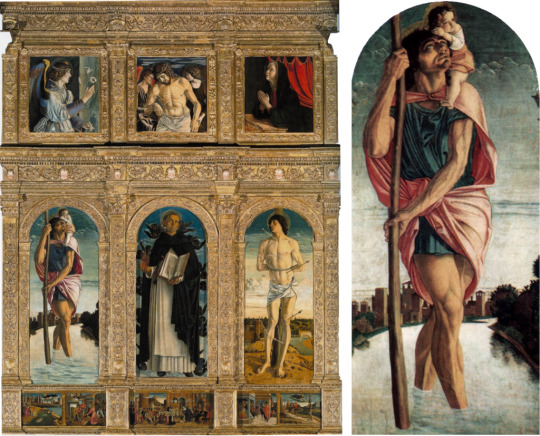
Left: Polyptych of St Vincent Ferrer, Basilica of SS Giovanni e Paolo, Venice ; Right: St Christopher carrying Christ from the Polyptch

Left: Close up of the Infant Christ on St Christopher's shoulder from the Polyptych; Right: Detail from Ashmolean Study
Clearly this is the type of the Child borne on the shoulder of Saint Christopher in the Saint Vincent Ferrer polyptych in the Basilica of SS Giovanni e Paolo in Venice, the same polyptych whose three predella panels we encountered in the discussion of the third ‘Giovanni Bellini’ painter, and must therefore disregard in our study of this fourth one. The six principal panels, three square above three arched, give us a good idea of this artist’s mature style and furnish us with a useful reference-source for further attributions. The Pieta, of Christ supported by Angels, at top centre, leads easily to a number of other things: to a Pieta in the Museo Civico at Rimini, to the Pieta at the Brera Gallery in Milan, to the Christ Blessing at the Louvre in Paris, and to a very impressive Head of Christ in the Kroller-Muller Museum at Otterlo in the Netherlands
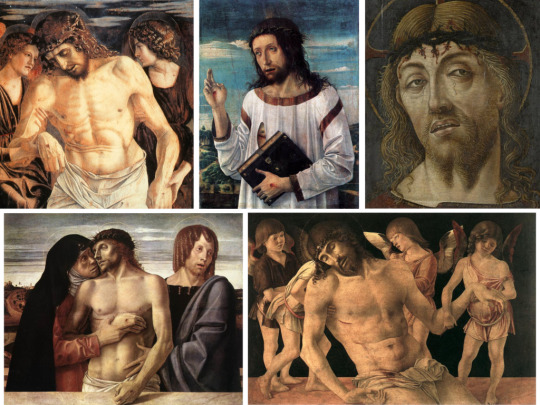
Clockwise from Top Left: The Dead Christ supported by Angels from the Polyptych ; Christ Blessing (attrib Bellini), Musée du Louvre, Paris ; Christ of Mockery (attrib Vittore Crivelli), Kröller-Müller Museum, Otterlo ; The Dead Christ supported by Angels (attrib G Bellini), Museo della Città, Rimini ; Pietà (attrib G Bellini), Pinacoteca di Brera, Milan
What is common to these images is principally a portrayal of Christ that is peculiar to this artist and not to be found in other ‘Giovanni Bellini’ painters looked at so far in these Studies, nor, as may appear subsequently, in any of those remaining to be considered. It is difficult to characterise this portrayal in words, but there is an asceticism expressed in the ‘hard’, chiselled planes of His face that brings us closer to Mantegna and the face of his Lamentation of Christ (as seen from His feet) in the Brera at Milan. Both men have conveyed a mood of silent acceptance of suffering and of death, and silent compassion with it. This lends itself naturally to a subdued and sombre palette, as if colour were drained out with the exhaustion of the breath of earthly life. The narrow range of subject-matter - variations on the Pieta theme - is indicative of the painter’s wish to focus on this ‘dead end’ of the Passion Story.

Details from the above paintings, highlighting the chiselled planes of Christ's face
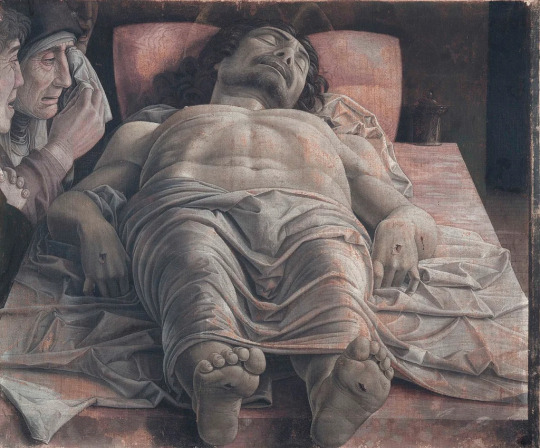
The dead Christ and Three Mourners (Mantegna) ; our artist's work bears some similarities with this, more so than with other works by Bellini
The head of Saint Sebastian in the panel at the top and right of the Saint Vincent Ferrer Polyptych has, to my eye, a sufficient generic likeness with that of an Unknown Man in a drawing, below, from Besancon. I have not found any ‘home’, as Berenson would say, for this fine work except in the oeuvre of this artist, and it certainly exhibits all the strength of modelling that characterises his art.

Portrait of a Man, Musée des Beaux-Arts et d'Archéologie, Besançon can be compared with St Sebastian from the Polyptych of St Vincent Ferrer
One has only to consider this portrait drawing to realise that this is an artist of great ability. To speak of assistants in the Bellini Workshop as if there was one great master in charge and minor talents at work around him is to grossly underestimate those talents, anonymous though they are and may remain. Their number is unknown and changed over time, but they were artists with varying temperaments and varying preferences when it came to subject-matter. It is hard to imagine the painter of the Madonna of the Meadow being regularly assigned Crucifixions - he was clearly a Madonna specialist - while this fourth artist, by contrast, must have been an obvious choice for the later scenes of the Passion.

The Calvary (attrib G Bellini), Musée du Louvre, Paris

Spacious landscapes and warm cool colours found in both the Brera Pietà and The Calvary
For me, one of the loveliest of this artist’s works is in the Louvre, The Calvary with Mary and Saint John. The sentinel figures either side of the Cross stand close to the picture plane, They perfectly balance the figure of Christ, but are separate enough to allow the eye to pass on into the spaciousness of a dawn landscape of sleepy brown hills, untravelled roads, grey-blue water of river and lake, grey-blue mountains in the distance. Trees - some breaking the skyline - provide markers plotting spatial relations. Everything is carefully composed: tall tree to left, tall tower to right, the Rood down the middle; its crossbar at the top, along which Christ’s arms are stretched, echo the flat line of cloud. All the colours, warm and cool, are subdued to the red robe of John and the blue one of Mary. Overall the mood is quiet, sombre, still.
This Louvre Calvary brings us back to the mood described earlier, regarding illustrations 6 to 11. It situates the Crucifixion in a landscape that seems to reinforce the solitary nature of the foreground vigil. Such emotional isolation of the Passion of Christ (when all the crowds and public spectacle are gone) is what appears to most engage the imagination of this artist, and it returns us to a picture such as the Brera Pieta which ‘bears witness’ by bringing the viewer as close as possible to the protagonists, eschewing all distraction, rather as Caravaggio was to do much later, and some war photographers do to this day.

Portrait of a Humanist (possibly Raffaele Zovenzoni or Peter Luder, attrib G Bellini, da Messina, Veneziano et al), Museo Castello Sforzesco
I suggest also a fine Portrait of a Young Man at the Castello Sforzesco museum in Milan. Note, as characteristic of this artist, the thin, pale outlining of the top of the upper lip and how this is continued into the pronounced fluting below the nostrils. This is all closely paralleled in the Brera Pieta where Mary shares as well the Young Man’s dimpled chin. His warm flesh-colour and the strong structure of the face with its prominent cheek bones fit well with what we have already encountered. Finally, what little we see of the toga-like robe knotted on his left shoulder has folds comparably treated in the robe of the left angel in the Pieta of the Saint Vincent Ferrer polyptych. It could be that the Young Man was the model for a Saint Sebastian, now at the Rijks Museum in Amsterdam and ascribed there to Francesco Bonsignori.
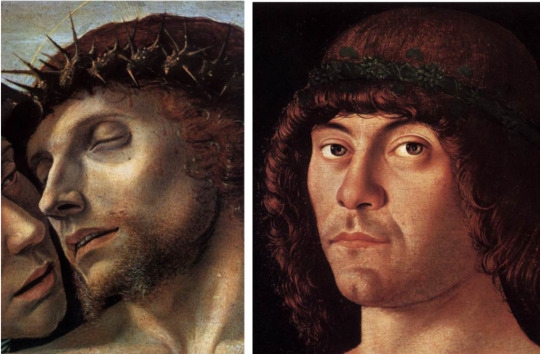
Distinctive lines of the lips and cleft chins present in both the Brera Pietà and the Humanist
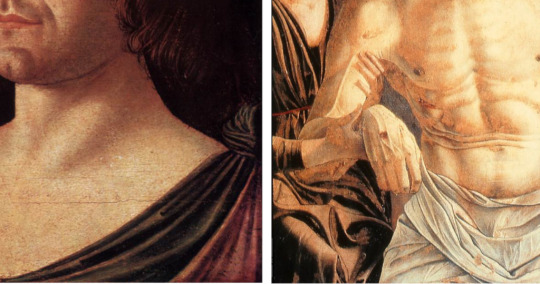
Folds of brown cloth from the Humanist (left) and the Polyptych (right)
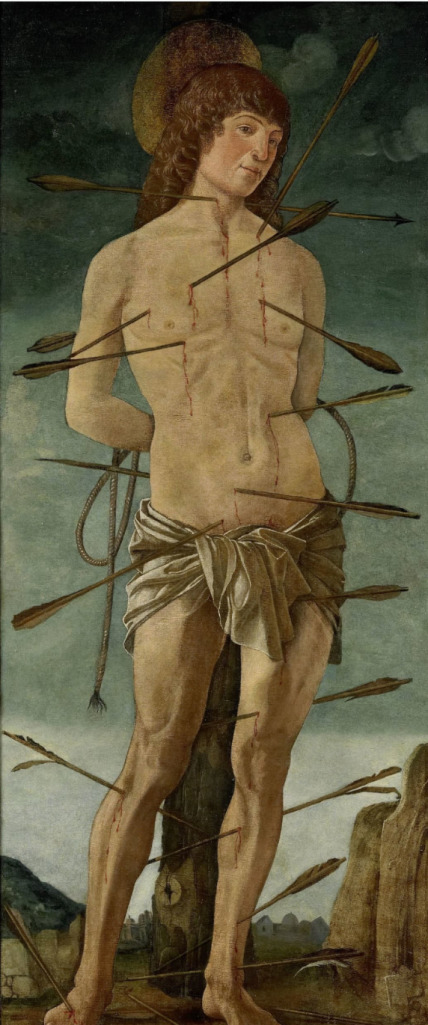
Saint Sebastian (attrib Bonsignori), Rijksmuseum, Amsterdam
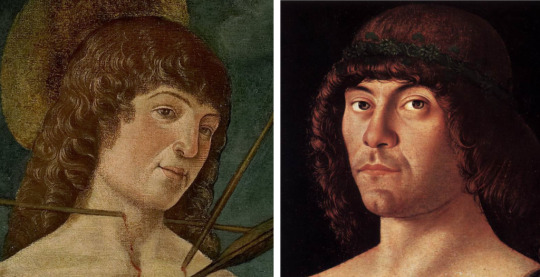
Facial similarities between the Humanist and Saint Sebastian

From Left: The Annunciation detail from the Polyptych ; The Greek Madonna, Pinacoteca di Brera, Milan ; Lochis Madonna, Accademia Carrara, Bergamo (all attrib G Bellini)
If we return to the Saint Vincent Ferrer polyptych in Venice (always ignoring the predella panels) and focus on the panel at top right showing Mary praying as she faces, across the Pieta, the Announcing Angel, it is possible to add to add to our oeuvre for this artist two fine Virgin and Child paintings, one with a Greek inscription that is in the Brera Gallery at Milan, and a later one known as the Lochis Madonna in the Accademia Carrara at Bergamo. The basis for these additions lies mainly in the facial type that is common to both and shared with the Mary Annunciate of the polyptych.
The Lochis Madonna is particularly rewarding for its literally arresting composition: the calm, pensive Mother restrains a very energetic Child who recoils from her as if startled by something she is not aware of - that prophetic premonition of the Passion, perhaps, that is more often suggested by symbols. This recoil to the right is countered by the veining of the marble making little ‘waves’ that run up to the left while, under the ledge, they flow to the right. Rhythmically and dynamically the folds of drapery on both Mother and Child are carefully disposed to form a thoroughly original design that makes this one of the best of all Bellinian Madonnas.

Left: Detail of an Angel from the Polyptych Right: Drawing of an Unknown Woman, whereabouts unknown
Thinking of these Madonna paintings in conjunction with the Angel of the Annunciation in the Saint Vincent Ferrer polyptych I am tempted to add a boldly modelled chalk drawing of an Unknown Woman, her head half-turned to our right. This was exhibited a long time ago as by ‘Giovanni Bellini’ in a 1966 exhibition at Monte Carlo of drawings from the Collection of H de Marignane. Where it is now I have no idea.

Two early 'Pietà's, Left: Museo di Poldi Pezzoli, Right: Museo Correr (both attrib G Bellini)

Comparing the Study of Infant Christ from the Ashmolean with the angels from the Correr Pietà
Finally here are two pictures of Christ stood in the Tomb, one, in the Poldi-Pezzoli Museum at Milan, where His arms are crossed, the other where they are held by two child angels, in the Correr Museum at Venice. I am reluctant to posit any chronology, but stylistically these do look earlier than the works considered above, though I can see similarities between the supporting Angels in the Correr picture, especially the right-hand one, and the Ashmolean drawing with which we began. The maturity that came later is evident if one compares these works with a comparable subject, a Dead Christ supported by Two Angels, at Berlin. There the Angel to our left is much closer to the Angel of the Annunciation of the Saint Vincent Ferrer polyptych.

Left: Berlin Pietà (attrib Bellini), Gemälde Gallerie, Berlin ; comparable to the previous Pietàs

Details from the Polyptych (left) and the Berlin Pietà (right)I
t is more than likely that in the future other works by this artist will be added to the tally, but for now I hope his separate identity has been established beyond reasonable doubt, and that what I attribute to him demonstrates a major talent, capable of producing drawn and painted images of exceptional plasticity. Strong modelling is at the service of the equally strong emotional themes of Christ’s Passion, most notably the Pieta. The frequency of those subjects suggests where his expressive potential lay.

Henry Moore was inspired by the Brera Pietà (left) to create a series of sketch studies, including this one from the Henry Moore Foundation
It was this emotional charge, combined with the sculptural modelling that must have impressed Henry Moore sufficiently to make him want to draw for himself (in 1975) the juxtaposed heads of Mother and Son in the Brera Pieta. That Moore thought the artist was Giovanni Bellini was natural enough, but in truth the name of the artist did not matter to him; he simply identified with the representation of a subject dear to him by a fellow artist of another age. The identity of the artist only matters if we care to identify the particular hand at work, and the imagination that dictated the form and style of what we see. As connoisseurs we need not to be fixated upon names. A distinguished artist like this one may never have a name attached to him, but what is left of his life’s work can live on, if we can indeed distinguish it.
#Giovanni Bellini#anonymous artist#renaissance art#accademia venice#brera#painting#art history#connoisseurship#studies in connoisseurship#passion of the christ#pieta#henry moore#mantegna#saint sebastian#saint christopher#besancon#kroller muller museum#ashmolean
3 notes
·
View notes
Photo

Seminatore al tramonto, Vincent van Gogh, olio su tela, 1888, Museo Kroller-Muller, Otterlo, Paesi Bassi.
1 note
·
View note
Photo
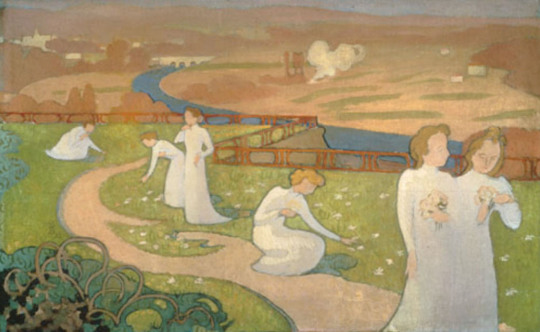
Maurice Denis - Aprile - 1892
17 notes
·
View notes
Photo

Vincent Van Gogh - Paesaggio con covoni di grano e luna che sorge - 1889
13 notes
·
View notes
Photo
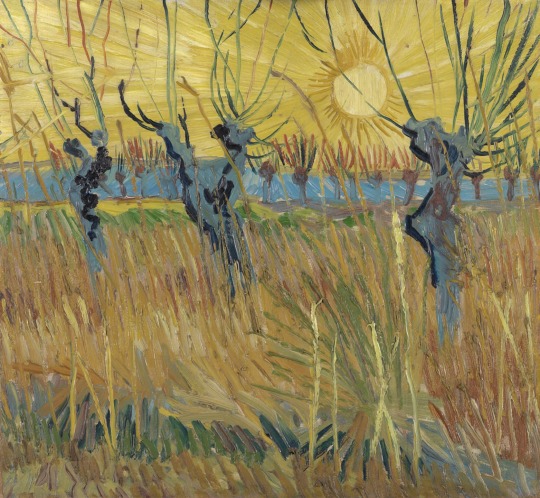
Vincent Van Gogh - Gelsi potati al tramonto - 1888
#vincent van gogh#museo kroller muller otterlo#postimpressionismo#van gogh vicenza#impressionismo treviso#van gogh londra
11 notes
·
View notes
Photo
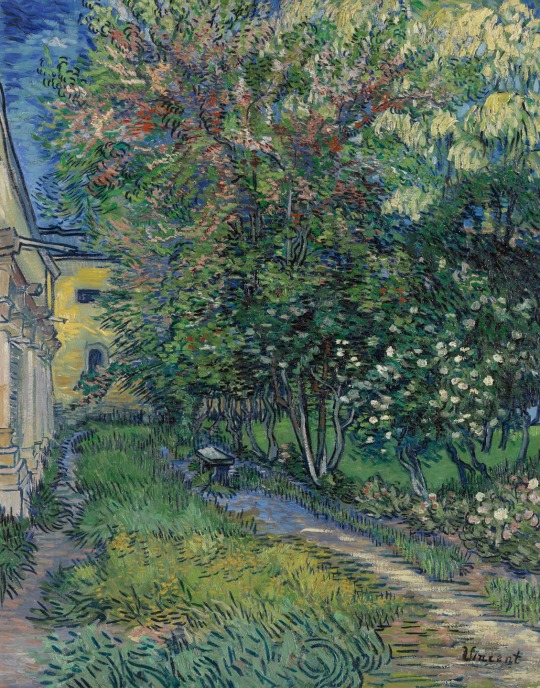
Vincent Van Gogh - Il giardino dell’ospedale a Saint-Rémy - 1889
10 notes
·
View notes
Photo

Paul Signac - La sala da pranzo - 1887
13 notes
·
View notes
Photo

Vincent Van Gogh - Pini al tramonto - 1889
9 notes
·
View notes
Photo

Vincent Van Gogh - Chiazza d'erba - 1887
8 notes
·
View notes
Photo

Odilon Redon - Il ciclope - 1914
3 notes
·
View notes
Photo

Vincent Van Gogh - Ritratto del sottotenente Milliet (L'amante) - 1888
2 notes
·
View notes
Photo

Vincent Van Gogh - Ritratto di un uomo - 1888
1 note
·
View note
Photo
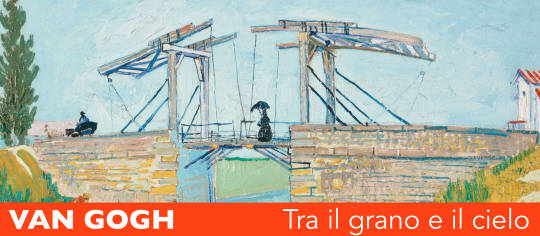
Van Gogh
Tra il grano e il cielo
Basilica Palladiana Vicenza
7 Ottobre 2017 - 8 Aprile 2018

La mostra presenta un numero altissimo di opere del pittore olandese, 43 dipinti e 86 disegni. Con l’apporto fondamentale del Kröller-Müller Museum in Olanda, ricostruisce con precisione l’intera vicenda biografica, una vera e propria via crucis nel dolore e nella disperazione del vivere.
1 note
·
View note